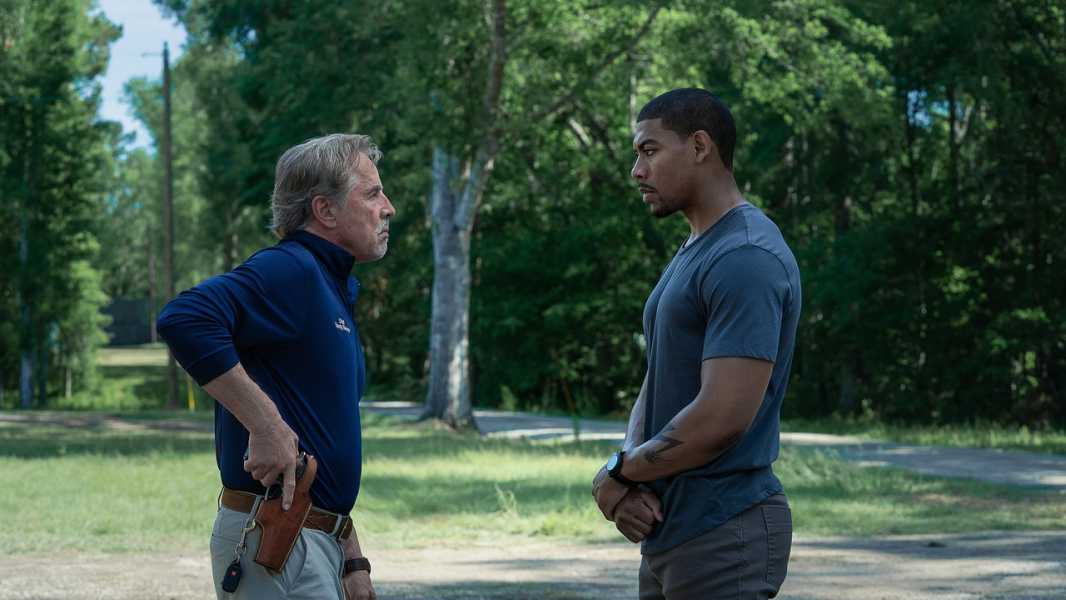
Save this storySave this storySave this storySave this story
A work of fiction that deals with a political problem can function like a fire alarm, impelling the public to a sense of urgency, or it can end up like a car alarm, fading into the mediascape. Jeremy Saulnier’s new film, “Rebel Ridge,” now on Netflix, fits uneasily in between, like an alarm that shuts itself off. An action drama about the widespread legitimation of abuses by police departments, it arrives onscreen with a jolt but then subsides into a comfort zone of formulaic tropes. The film is set in a fictional small town in rural Louisiana called Shelby Springs, whose police department fills its coffers through civil forfeitures, enacted wantonly and without legal justification by its officers. This ongoing effort has created a web of cruelty, deceit, and corruption in which many unfortunate people are ensnared.
One of those unfortunates is the movie’s protagonist, Terry Richmond (Aaron Pierre), a young Black man who is cycling into town, a knapsack on his back, in order to put up bail for a cousin. On a long and desolate country road, a pair of officers (played by Emory Cohen and David Denman) intentionally knock him off the bike with their car. Without officially arresting him, they detain him and subject him to a search, coercing his consent with threats. In his backpack, they find a bag of cash—thirty-six thousand dollars, ten thousand of which is meant for bail, and the rest to buy a truck and start a boat-hauling business. Asserting suspicion that the money is rather a part of a drug-dealing conspiracy, they confiscate the money and send him on his way.
At first, Terry assumes that the officers are bad apples who’ll be disciplined when he reports the incident to their superiors as a robbery. Fat chance: the police chief, Sandy Burnne (Don Johnson), issues chilling warnings to drop the matter, and even when he makes an apparent gesture of understanding and generosity it turns out to be a cold and cruel deception. Meanwhile, the clock is running out for Terry’s cousin, Mike Simmons (C. J. LeBlanc), who is at risk of transfer from the local jail to a state prison. As the department’s official misdeeds expand to harm others in Terry’s circle (including a former business associate), the drama ramps up.
But Terry isn’t alone. When he fails to get any help from the town’s apathetic court clerk (Steve Zissis), a young court assistant named Summer McBride (AnnaSophia Robb), a sympathetic but circumspect law student who knows well how closely she’s being watched by suspicious superiors, guides Terry through a labyrinth of corruption. She covertly rummages through files and discovers a dubious pattern of apparent collusion between the police and the local court, involving questionable arrests and incarcerations. Once he realizes that legal avenues are hopeless, Terry—a marine veteran and a martial-arts expert—turns his resistance kinetic.
It would be wrong to go into much more detail about the action. Suffice it to say that Terry intrepidly engages in physical confrontations with a force that far outnumbers and outguns him; that officials go to extreme lengths to get Terry far away and keep him quiet; and that those who abet Terry in his quest are subject to alarming reprisals. It’s also no spoiler to say that the film probes the racism that underlies the persecution of Terry. For the most part, however malevolent the members of the police department may be, their racism remains implicit, if unmistakable. But one telling moment gives voice to what otherwise goes unsaid—a repugnant reminiscence of Jim Crow violence, addressed to Terry within earshot of the department’s one nonwhite officer, a Black woman named Jessica Sims (Zsané Jhé).
Saulnier’s script suggests his thorough research into the fine points of police procedure, licit and illicit, and likewise into the intricacies of judicial authority and hand-to-hand combat (including minutiae about firearms and ammunition). But, to keep the action moving and the plot points mounting, the dialogue is rarely more than businesslike, and characterization that exceeds the bare needs of the plot is filled out mainly by the personalities and mannerisms of the actors playing the roles. The film’s attempt to blend a backstory of governmental turpitude with daring adventure—capped off by the heroic resistance (preordained to succeed) of a victim of racist persecution—amounts to a satisfyingly plotted thriller of locked-in but superficial gratifications.
The great danger of genre is that it provides a ready-made excuse for any shortcuts taken to fulfill its conventions. Once the movie’s many sequences of tense showdowns and looming menace are set up, the main suspense is technical: whether the characters can pull off their plans and save themselves from peril. “Rebel Ridge” has the framework of a richly developed drama of local corruption—a movie that would implicate the region’s deep history, reflect contemporary politics, and catch the connections to modern American life at large. Instead, what’s most substantial about the movie is reduced to an elaborate windup toy, a mechanism of mere spectacle.
All the same, Saulnier’s approach to this spectacle is far from routine. Except for a few flurries of dialogue registering key information or emotional beats and sudden flashes of violence, “Rebel Ridge” is paced surprisingly slowly. For most of the film’s two-plus hours, viewers would be unlikely to miss much by watching out of the corner of their eyes, until something—a noise, a silence, a movement—cues them to pay attention. In a movie theatre, such distention of its narrative would likely be a drag and feel like a time suck. Nonetheless, Saulnier is a step ahead of the competition when it comes to the creation of a consumer product designed to be watched with a certain amount of distraction: he develops its necessity into an aesthetic.
The stepwise pace of “Rebel Ridge” is matched by a performance style of a classical, sculptural solidity. As in high-studio-era Hollywood movies, the actors in Saulnier’s film talk without moving; they face off in tensely controlled stillness, flaunt their dynamic immobility, and speak with a terse, drawn-out, and tamped-down precision to match. As a result, behavior that’s slowed to a literalizing and spoon-fed crawl also comes off as heightened and stylized. This unusually reserved aspect of performance gives the actors a more distinctive showcase than do the blatant theatrics of most movies. The martial artistry and athletic energy that most of the cast members are called upon to deploy are far less significant, impressive, and crucial to the movie’s over-all effect than the tautly urgent restraint with which they confront one another. The film’s hectically choreographed violence has less power than the characters’ subtle yet precise glances of recognition or hostility or complicity. The movie’s physicality, at its most vital, is infinitesimal. ♦
Sourse: newyorker.com






